A multiplexer (MUX) selects one input from multiple signals and forwards it to a single output line, optimizing data routing and signal management in hardware circuits. In contrast, a demultiplexer (DEMUX) takes a single input and distributes it to one of several output lines, enabling controlled signal distribution. Both components are essential in digital systems for efficient data flow and resource utilization.
Table of Comparison
| Feature | Multiplexer (MUX) | Demultiplexer (DEMUX) |
|---|---|---|
| Function | Selects one input from multiple inputs and forwards it to a single output | Distributes a single input signal to one of many outputs |
| Purpose | Data selection and routing | Data distribution and channel selection |
| Number of Inputs | Multiple inputs (2n inputs, where n = select lines) | Single input |
| Number of Outputs | Single output | Multiple outputs (2n outputs, where n = select lines) |
| Control Inputs | Selection lines to choose input | Selection lines to choose output |
| Common Use | Data routing in digital circuits | Signal distribution in communication systems |
| Logic Type | Combinational logic | Combinational logic |
Introduction to Multiplexers and Demultiplexers
Multiplexers (MUX) and demultiplexers (DEMUX) are essential components in digital hardware engineering used to manage data paths efficiently. A multiplexer selects one input from multiple data inputs and forwards it to a single output line, optimizing signal routing and minimizing wiring complexity. Conversely, a demultiplexer takes a single input and channels it to one of several outputs based on selection signals, enabling precise data distribution across different circuits.
Core Functions: What is a Multiplexer?
A multiplexer (MUX) is a critical hardware device in digital circuits that selects one input line from multiple data inputs and forwards it to a single output line based on select signals. It efficiently manages data routing by controlling multiple data streams and reducing the number of required communication lines. Multiplexers are widely used in communication systems, data acquisition, and resource-sharing applications to optimize signal transmission and minimize hardware complexity.
Demultiplexer Explained: Key Operations
A demultiplexer (DEMUX) directs a single input signal to one of many output lines based on select lines, effectively distributing data from one source to multiple destinations. It operates by interpreting the select input as a binary number, enabling the channeling of the input to the specific output corresponding to that binary value. Demultiplexers are essential in hardware engineering for signal routing, data distribution, and resource sharing in communication systems and digital circuits.
Architecture and Signal Flow Comparison
A multiplexer (MUX) architecture consolidates multiple input signals into a single output line by using selection lines to control which input is transmitted, optimizing signal routing in hardware circuits. In contrast, a demultiplexer (DEMUX) architecture takes a single input signal and channels it into one of many output lines based on control signals, enabling efficient signal distribution. The signal flow in a MUX is from many inputs to one output, whereas in a DEMUX, the signal flow reverses from a single input to multiple outputs, reflecting their complementary roles in digital communication systems.
Types of Multiplexers and Demultiplexers
Types of multiplexers include 2-to-1, 4-to-1, 8-to-1, and 16-to-1 configurations, each designed to select one input from multiple channels based on control signals. Demultiplexers are commonly categorized as 1-to-2, 1-to-4, 1-to-8, and 1-to-16, used to route a single input data line to one of many output lines. Both devices utilize different numbers of select lines to determine the active input or output path, essential for efficient data routing in digital circuits.
Applications in Modern Hardware Design
Multiplexers are vital in modern hardware design for efficiently managing data streams by selecting one input from multiple sources, reducing the number of data lines needed in communication systems and memory management. Demultiplexers play a crucial role in distributing a single data input to multiple output lines, extensively used in display systems, routing data to specific hardware modules, and expanding data buses in microprocessors. Both components enhance system flexibility and scalability in complex circuits such as FPGA configurations and digital signal processing units.
Benefits and Limitations: MUX vs DEMUX
Multiplexers (MUX) offer the benefit of reducing the number of data lines required by selecting one output from multiple inputs, which enhances efficient data routing and minimizes hardware complexity. Demultiplexers (DEMUX) distribute a single input signal to one of many output lines, enabling precise signal delivery but potentially increasing design complexity with additional control lines. While MUX improves channel utilization and reduces circuit size, DEMUX provides flexibility in signal distribution but can introduce latency and requires careful management of output line contention.
Implementation in Digital Circuits
Multiplexers and demultiplexers are fundamental components in digital circuit implementation, enabling efficient data routing and signal management. A multiplexer selects one input line from multiple inputs and forwards it to a single output, reducing the number of data paths required. Conversely, a demultiplexer takes a single input and channels it into one of several outputs, facilitating signal distribution across different circuit segments.
Design Considerations and Selection Criteria
Multiplexer design prioritizes minimizing propagation delay and power consumption while ensuring high signal integrity for efficient data channel selection across multiple inputs. Demultiplexer selection criteria focus on output isolation and drive strength to effectively distribute a single input signal to multiple outputs without signal degradation. Key factors include input/output line number, switching speed, and compatibility with the system's voltage and timing requirements to optimize overall hardware performance.
Future Trends in Multiplexing Technology
Emerging advancements in multiplexing technology emphasize increased data throughput and reduced latency through photonic and quantum multiplexers, enabling superior bandwidth management in hardware systems. Integration of AI-driven control algorithms optimizes dynamic channel allocation, enhancing signal clarity and power efficiency in complex hardware environments. Future multiplexers will likely leverage nanotechnology to miniaturize components, improving scalability and compatibility with next-generation semiconductor devices.
Multiplexer vs Demultiplexer Infographic

 techiny.com
techiny.com